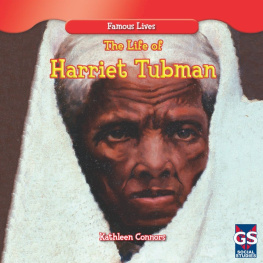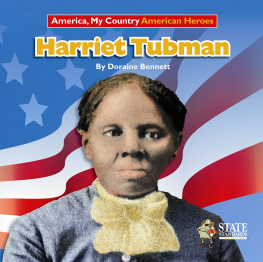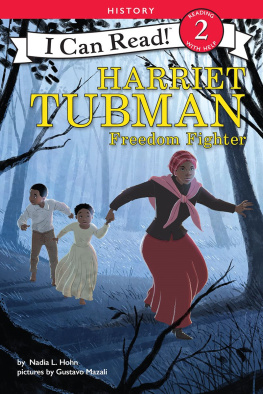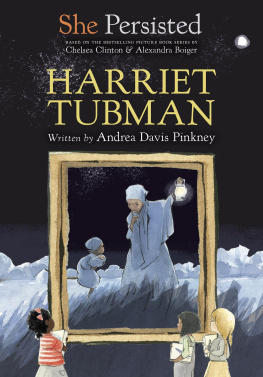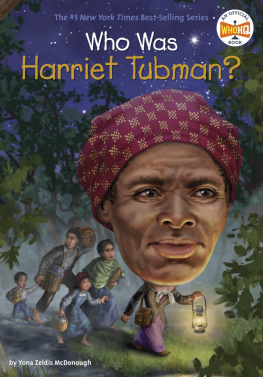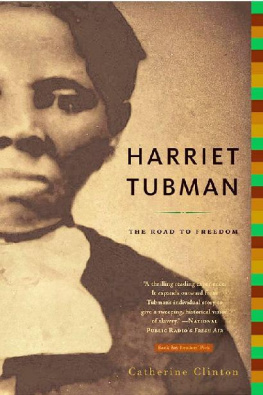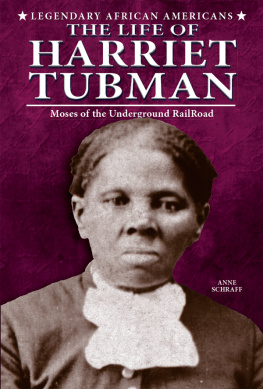University Press - Harriet Tubman: The Biography
Here you can read online University Press - Harriet Tubman: The Biography full text of the book (entire story) in english for free. Download pdf and epub, get meaning, cover and reviews about this ebook. year: 2020, publisher: University Press, genre: Non-fiction. Description of the work, (preface) as well as reviews are available. Best literature library LitArk.com created for fans of good reading and offers a wide selection of genres:
Romance novel
Science fiction
Adventure
Detective
Science
History
Home and family
Prose
Art
Politics
Computer
Non-fiction
Religion
Business
Children
Humor
Choose a favorite category and find really read worthwhile books. Enjoy immersion in the world of imagination, feel the emotions of the characters or learn something new for yourself, make an fascinating discovery.
- Book:Harriet Tubman: The Biography
- Author:
- Publisher:University Press
- Genre:
- Year:2020
- Rating:3 / 5
- Favourites:Add to favourites
- Your mark:
- 60
- 1
- 2
- 3
- 4
- 5
Harriet Tubman: The Biography: summary, description and annotation
We offer to read an annotation, description, summary or preface (depends on what the author of the book "Harriet Tubman: The Biography" wrote himself). If you haven't found the necessary information about the book — write in the comments, we will try to find it.
Harriet Tubman: The Biography — read online for free the complete book (whole text) full work
Below is the text of the book, divided by pages. System saving the place of the last page read, allows you to conveniently read the book "Harriet Tubman: The Biography" online for free, without having to search again every time where you left off. Put a bookmark, and you can go to the page where you finished reading at any time.
Font size:
Interval:
Bookmark:
HARRIET
TUBMAN
Copyright 2019
University Press
All Rights Reserved
Want to Fill Your Kindle Library For Free?

Join Our Exclusive Reviewers Club
and Get a Free Kindle Book
in Your Inbox Every
Friday.
Click Here to Join Our Reviewers Club!
For decades, children have learned in school that Harriet Tubman was a conductor for the underground railroad, helping slaves reach freedom. Not much else is usually discussed, and for most, the complete story of her life is a mystery. Most of this courageous and multi-faceted woman's life has largely been ignored.
Myths and rumors surround her earlier years as people try to guess where she came from and how she came to be a key player in the abolitionist movement. However, the information is available, primarily through oral history, letters, biographies written during her lifetime, and a few official documents. It takes some digging to get to the bottom of the story, but it is possible.
Harriet Tubman was born a slave but found her way to freedom. Yet, she was not satisfied to stop at caring for her own welfare. She went on to save others from the degradation and harsh conditions of slavery. Her contributions to the abolitionist cause did not end there, either. She worked with the union army, taking on dangerous assignments for the benefit of all the slaves and, indeed, for the betterment of the entire country.
Without Harriet Tubman and others who fought from the inside, the Civil War might have gone very differently. Her life was and is an inspiring example of what one person can do to right wrongs and change the world for the better.
One short book, or even several full-length biographies, cannot possibly tell the complete story of who Harriet Tubman was, nor the great lengths she went to in order to fight for a noble cause. Still, this short biography will give the reader a greater understanding and appreciation for this extraordinary figure.
Long ago, a powerhouse of a woman brought intelligence, courage, and persistence to the monumental task of overcoming slavery. Harriet Tubman inspired the people of her time, and her example continues to speak to the human need to see beyond our struggles to affect change in the world.
Harriet Tubman was named Araminta "Minty" Ross when she was born. No one knows the exact date of her birth. In fact, she herself listed the year of her birth on different documents as 1820, 1822, and 1825, suggesting that even she did not know. This is just one example of how the institution of slavery disrupted family histories. Recently a document was uncovered that showed a payment for a midwife to deliver a slave child that many historians believe was Harriet. If this is true, her birth date would have been in February or March of 1822.
Aramintas mother, Harriet Rit Green, and her father, Ben Ross, were both slaves on Maryland plantations. Rits mother, Modesty, had been brought to the United States from Africa. Araminta had heard that Modesty came from what is now Ghana, but no records survive to support this story. Rit was held by Mary Pattison Brodess, and was a cook for that family. Ben was a woodsman for his slave owner, Anthony Thompson. Brodess and Thompson married after Brodesss husband died. Marys son, Edward, would soon turn 21, and when he did, he would take ownership of Rit and her family, but not Ben.
Ben and Rit had at least nine children together. Minty came along fifth. After Edward turned 21, he split up the family. Later, he sold Mintys sister, Mariah Ritty, to a Mississippi slave trader. The family would never see Ritty again. Edward sold two of her other sisters, Linah and Soph. When he tried to sell Mintys youngest brother, Moses, Rit hid him as long as she could. When Brodess found the child, Rit told him she would split his head open is he came for the child. Thus, Minty got her first exposure to the idea of standing up to a slave master.
When Minty was about five or six, Edward sent her away to work on another landowner's plantation. This was common practice, especially for a landowner like Edward, who had more slaves than he needed. Her first job was with the James Cook family, learning to weave. Cook also sent her out to check his muskrat traps, a cold, wet job that he forced her to do even when she was ill. Cook often beat her. She never learned to weave. When she came down with the measles, she was no longer useful to Cook at all, so he sent her back to Edward Brodess.
Later on, Minty went to work for a slave owner she knew as Miss Susan. Although little Minty did her best, she had never been taught how to take care of a house. Miss Susan whipped her, often several times a day. At night, Minty had to rock Miss Susans babys cradle. If she fell asleep and the baby cried, Miss Susan would grab the whip she kept under her pillow and beat her again.
Minty ran away from Miss Susan after her mistress saw her taste her first lump of sugar. She ran for miles, but there was nowhere for her to go, no one to take her in. She ended up hiding in a barn, fighting for the scraps that were put out for the pigs. Hungry, weak and alone, Minty went back to Miss Susans, where she was beaten fiercely with a knotted rope. Thin, weak and injured, Minty once more needed her mother to nurse her back to health before she would be of use. Each time she recovered, she was sent off to work away from her mother. However, the worst was still to come.
Throughout her childhood, Minty had been owned by first Mary and then Edward Brodess, even though she had spent much of the time working at other plantations. One landowner after another took her and then sent her back when she was too weak, sick, or injured to do the housework. Finally, Brodess tried to sell her. When he couldn't, he made her a field slave.
Edward hired her out to work for a landowner who was the most notorious for mistreating slaves. He beat her regularly and did not give her enough food to eat. One day, he sent a teenaged Minty along with his cook to pick up some items for him at the store.
While Minty stood waiting for the shopowner, a runaway slave came rushing into the store. Next came the overseer, who had tracked the young male slave to that location. The overseer grabbed the runaway and demanded that Minty help him hold onto the youth so he could beat him. Minty refused.
The overseer picked up a heavy weight and lobbed it at the young black man. The weight missed the runaway, though, and bashed into Minty's head. She fell to the ground but eventually revived enough to be taken back to the plantation. There, other slaves found a place for her to sit at a loom, the only seat available. No doctor was sent to see to her injuries. After two days in and out of consciousness, she was sent back to work in the fields. As she worked, blood continued to flow from her head wound.
Medical historians suggest that her injury resulted in temporal lobe epilepsy due to the signs she displayed afterward. She had vivid dreams, which she remembered and relied on to guide her in her life. She had waking visions that varied from the horrifying to the beautiful. Often when she was busy doing something, she would fall fast asleep. Some have suggested this was narcolepsy, but the consensus is that it was a symptom of the temporal lobe epilepsy. She also had severe headaches and even seizures. All these symptoms continued for the rest of her life.
Harriet Tubman was a deeply religious woman, but her faith was her own unique mixture of African, Baptist, Catholic, and Methodist faiths she had encountered. Her premonitions and visions sometimes centered on religious themes. Although Minty was exposed to the New Testament, she could not accept the passages that instructed slaves to be obedient to their masters. She became fascinated with the Old Testament stories of deliverance, instead.
Font size:
Interval:
Bookmark:
Similar books «Harriet Tubman: The Biography»
Look at similar books to Harriet Tubman: The Biography. We have selected literature similar in name and meaning in the hope of providing readers with more options to find new, interesting, not yet read works.
Discussion, reviews of the book Harriet Tubman: The Biography and just readers' own opinions. Leave your comments, write what you think about the work, its meaning or the main characters. Specify what exactly you liked and what you didn't like, and why you think so.



